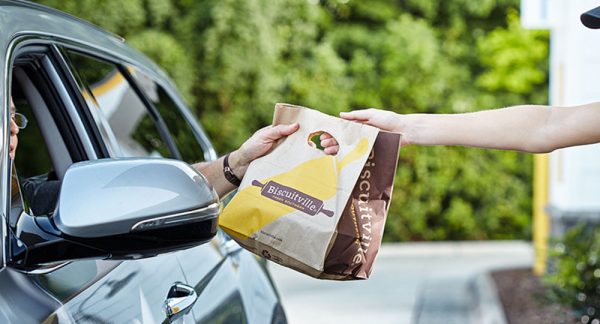

October 4, 2023 | QSR Magazine
One modern marketing strategy tells companies to “meet customers where they are.” That could be amended in the limited-service restaurant industry to “meet customers where they drive.”
As the percentage of customers using drive-thru lanes at quick-service and fast-casual restaurants has grown, an increasing number of dining brands of all sizes have considered—and gone forward with—launching drive-thru-centric units, many with pickup options.
Even before COVID-19 hit in 2020, operators were looking beyond the rising number of consumers using drive-thrus to a variety of other issues, including higher costs for labor, construction, energy, and real estate, as well as diners’ move toward digital ordering.
That activity accelerated during the pandemic, as many restaurants became essentially drive-thru-only units because their dining rooms were closed for weeks at a time. Operators found they could still be profitable by having drive-thrus, pickup options, and delivery options alone.
The increased push for drive-thru and pickup-only stores “was definitely driven by COVID,” says Maeve Webster, president of Vermont-based foodservice consultant Menu Matters. While off-premises visits have dipped some since, “they are still higher than pre-pandemic.”
It makes sense for operators to look at the drive-thru-only option due to the potential “enormous number of efficiencies and benefits” that such a move could provide, she notes. These range from requiring a smaller footprint to improved speed of service.
The challenge with drive-thru and pickup-only locations is for companies to avoid relegating these units solely to providing customers with “transactional events,” not a brand connection, Webster states. Otherwise, the stores become “nothing more than large vending machines.”
Still, there are logical sites for these units, she adds, especially as fill-in locations between a company’s regular restaurants and in high-density urban areas with expensive real estate and where customers are seeking a quick meal to eat while traveling or to take to the home or office.
Several companies are doing exactly that, dipping their toe into the drive-thru-only pool with a handful of initial units and plans to add more. Many require less than an acre of land, fewer employees, and various cost savings, albeit with lower sales numbers than dine-in ones.
North Carolina-based Biscuitville also has dubbed its drive-thru-only spots Express. The units are about 1,800 square feet—more than a third smaller than full-size ones—and feature two order lanes that merge into one pay lane plus a walk-up window with a couple of outside tables.
“Before COVID, we were doing approximately 70 percent [of sales] through the drive-thrus,” states Blake Jennings, chief development officer. “Post-COVID it’s been about 80 percent. Because of that, it made sense to test drive-thru-only units.”
The first Biscuitville Express was a conversion in its hometown of Greensboro, North Carolina, while the initial new build is in nearby Burlington. The plan for now is that the drive-thru-centric stores will be in urban markets that already have several dine-in locations.
“This will help us grow because of additional site availability,” he says, explaining that the Express locales require just seven-tenths of an acre, about half that of a regular unit. Not only are the buildings smaller, but less space is needed for parking.
The drive-thru-only units are expected to result in a 15 percent development cost savings per unit, including construction and equipment, such as one fewer HVAC unit and restroom. Operationally, “we will be able to manage labor better,” Jennings notes, plus kitchen efficiencies.
“We’re looking at a one-to-two-year horizon to tell how successful these will be,” he adds, but “sales preliminarily look like we will be happy.”